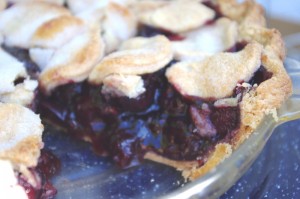 Because there can never be enough pie in this world …
Because there can never be enough pie in this world …
Somtimes, when cooking for clients, some some creativity and trial and error in order to come up with recipes that meet their specific dietary needs, and I end up learning something in the process! Case in point, a client with a number of food issues has had a craving for chicken pot-pie — specifically pastry and chicken gravy — after many years of avoiding it due to issues with gluten, rice, potatoes, eggs, and dairy.
…So the challenge was, not so much the gravy, for which cornstarch or tapioca starch would do, in a pinch, but around the pastry., for which I normally rely on a tried and true recipe that is brown-rice flour based. The brown rice flour adds texture, flavour and nutritional value, and is rounded out by tapioca starch and potato starch, and uses an egg for binder and moisture for best results. I have seen (and tested) many recipes for mainly starch-based pastry, but found the texture too smooth for my liking, and too bland to stand up to savoury fillings.
So after a few tweaks to the old standby (amaranth to the rescue!!!) the resulting piecrust turned out to be better than my previous version! so much so, that I think I will be adopting this as the new "standard".
It converts to a sweet pie crust with the addition of a couple of tablespoons of sugar, if that's your thing. If you want to use egg as binder to make it easier to roll out, just whisk the egg first and use in place of the water. If you prefer butter, go ahead and use it in place of the shortening — this recipe was made to be egg and dairy-free, but butter works equally well.
Some of the things that work well in this recipe are the inclusion of tapioca starch to add a bit of chew and binding, cornstarch to promote crispness on the exterior, and amaranth flour to add flavour, texture, nutritional value and also promote browning (nothing is worse than a pallid pie-crust!!!). Finally, a little bit of baking powder helps "lift and separate" the flaky layers.
I tested this out late last night with cherry pie filling, and you can see it stands up quite well to moist fruit pie fillings. It can be sweetened, but works quite well unsweetened with both sweet and savoury fillings.
As with any pie crust, be sure to let it rest in the fridge for at least 30 minutes — overnight is better, to allow the flours and xantham gum to fully hydrate. Roll it out carefully, as it will be stickier than wheat-based pastry, in between layers of plastic wrap or parchment, with lots of flour (I used amaranth flour), and make sure to let it chill before you bake it to avoid having droopy edges.
Gluten-free pie crust remix
(makes 1 double pie-crust)
- 2/3 cup amaranth flour
- 2/3 cup tapioca starch
- 2/3 cup cornstarch
- 1 tsp. baking powder
- 1 Tbs. xantham gum
- 1 tsp. salt
- 1 cup vegetable shortening (Earth Balance buttery sticks) OR butter, cold and cut in small pieces
- 2 tsp cider vinegar
- up to 1/2 cup ice cold water OR 2 eggs
Combine all the dry ingredients in a medium bowl and whisk well to combine. Cut in the shortening (or butter) with a pastry cutter, until the butter is no bigger than the size of small peas. Combine the vinegar and water (or eggs) and add slowly to the flour/shortening mixture, just until the pastry comes together and forms a ball when squeezed.
Form into a ball, and wrap in plastic wrap and let the pastry rest at least 30 minutes, or overnight. (you can also freeze the dough at this point)
Roll out the dough on a silpat mat, or between two pieces of plastic wrap or parchment paper, with a liberal dusting of amaranth flour.
Use in your favourite pie recipe!
My latest Tweets
- Back bar at Cocktail Bar http://t.co/6j7HZDK6
- @cqwww you've been pwned? #godhelpusall
- @Rosger graphic design? If you don't have @magarethanson design on your list you are missing out!
- @ClivesClassic @yukarip @Roger_Kershaw @grumpypuppy we'll be back! Talking you up here in TO!
- I'm at Cocktail Bar (923 Dundas St W, at Bellwoods Ave, Toronto) http://t.co/GW0UPqa2






